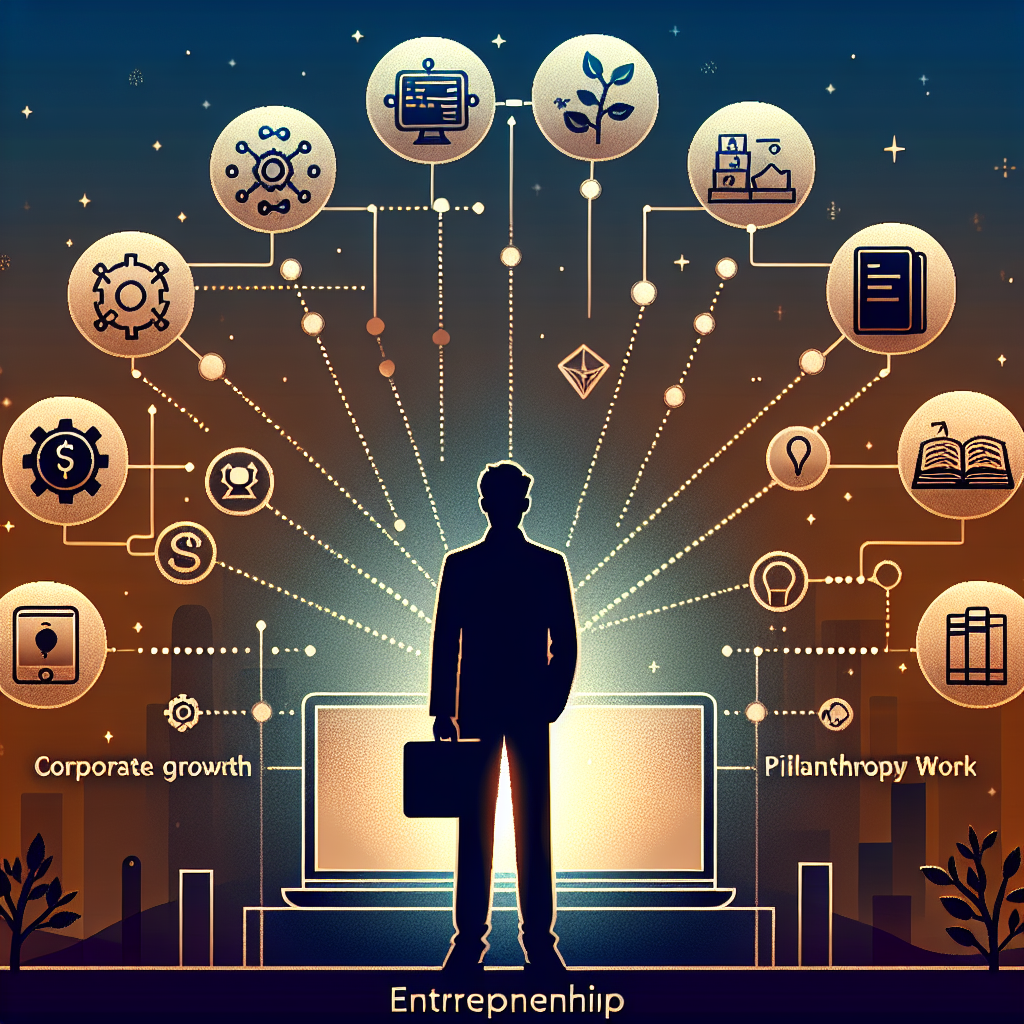Bill Gates on Leadership: What Every Entrepreneur Should Know
Visionary Thinking: How Bill Gates Sees the Future
Bill Gates, co-founder of Microsoft and one of the most influential figures in the tech industry, has long been admired for his visionary thinking and leadership skills. His ability to foresee technological trends and adapt to changing landscapes has not only shaped Microsoft but also set a benchmark for entrepreneurs worldwide. Understanding how Bill Gates sees the future can provide invaluable insights for anyone looking to lead with innovation and foresight.
One of the key aspects of Gates’ visionary thinking is his relentless focus on the long-term. While many business leaders are preoccupied with quarterly earnings and short-term gains, Gates has always emphasized the importance of looking ahead. This forward-thinking approach was evident when he predicted the rise of personal computing long before it became a household necessity. By envisioning a future where every desk would have a computer, Gates was able to steer Microsoft towards developing software that would become indispensable in the digital age.
Moreover, Gates’ ability to anticipate and adapt to technological shifts has been a cornerstone of his leadership. For instance, when the internet began to gain traction in the mid-1990s, Gates quickly recognized its potential to revolutionize the way people communicate and access information. This led to Microsoft’s pivot towards internet-based technologies, ensuring that the company remained at the forefront of innovation. Entrepreneurs can learn from this by staying informed about emerging trends and being willing to pivot their strategies when necessary.
In addition to his focus on technology, Gates has always been a strong advocate for continuous learning and curiosity. He is known for his voracious reading habits and his commitment to staying informed about a wide range of topics. This intellectual curiosity has enabled him to draw connections between different fields and come up with innovative solutions to complex problems. For entrepreneurs, fostering a culture of continuous learning within their organizations can lead to more creative and effective problem-solving.
Another important lesson from Gates’ visionary thinking is the value of collaboration and building strong teams. Gates has often credited Microsoft’s success to the talented individuals he worked with and the collaborative environment they created. By surrounding himself with experts and encouraging open communication, Gates was able to harness the collective intelligence of his team. Entrepreneurs should recognize that no one can achieve great things alone and that building a strong, collaborative team is essential for long-term success.
Furthermore, Gates’ philanthropic efforts through the Bill and Melinda Gates Foundation highlight the importance of using one’s influence and resources for the greater good. His commitment to addressing global challenges such as poverty, disease, and education demonstrates a broader vision that extends beyond business success. Entrepreneurs can take inspiration from this by considering how their ventures can contribute positively to society and by integrating social responsibility into their business models.
In conclusion, Bill Gates’ visionary thinking offers a wealth of lessons for entrepreneurs. By focusing on the long-term, staying adaptable, fostering continuous learning, building strong teams, and considering the broader impact of their actions, entrepreneurs can lead with the same foresight and innovation that has defined Gates’ illustrious career. As the business landscape continues to evolve, these principles will remain crucial for those looking to navigate the future successfully.
Strategic Decision-Making: Lessons from Bill Gates
Bill Gates on Leadership: What Every Entrepreneur Should Know
Strategic Decision-Making: Lessons from Bill Gates
When it comes to strategic decision-making, few individuals have demonstrated the prowess and foresight of Bill Gates. As the co-founder of Microsoft, Gates has navigated the complex landscape of the tech industry with a blend of innovation, pragmatism, and an unwavering commitment to his vision. For entrepreneurs seeking to emulate his success, understanding the nuances of his approach to strategic decision-making can provide invaluable insights.
One of the key lessons from Gates is the importance of having a clear vision. From the outset, Gates had a distinct idea of what he wanted Microsoft to achieve. This vision was not just about creating software but about making a significant impact on how people interact with technology. By maintaining a clear and consistent vision, Gates was able to steer Microsoft through various challenges and opportunities, ensuring that every strategic decision aligned with the company’s long-term goals. For entrepreneurs, this underscores the necessity of having a well-defined vision that can guide decision-making processes and keep the organization focused on its core objectives.
In addition to having a clear vision, Gates emphasizes the importance of staying informed. He is known for his voracious reading habits and his commitment to continuous learning. By staying abreast of industry trends, technological advancements, and market dynamics, Gates was able to make informed decisions that kept Microsoft at the forefront of innovation. Entrepreneurs can take a page from Gates’ book by prioritizing knowledge acquisition and staying informed about their respective industries. This not only aids in making better strategic decisions but also helps in anticipating and adapting to changes in the market.
Moreover, Gates’ approach to risk management offers valuable lessons for entrepreneurs. While he is often seen as a visionary, Gates is also a pragmatist who understands the importance of calculated risks. He has always been willing to take bold steps, such as the decision to shift Microsoft’s focus from software to cloud computing. However, these decisions were never made on a whim; they were the result of careful analysis and a deep understanding of the potential risks and rewards. Entrepreneurs should strive to balance their innovative impulses with a pragmatic approach to risk management, ensuring that their strategic decisions are both bold and well-considered.
Another critical aspect of Gates’ strategic decision-making is his focus on building a strong team. Gates has always recognized that the success of Microsoft was not solely due to his efforts but also to the contributions of a talented and dedicated team. By surrounding himself with individuals who shared his vision and complemented his skills, Gates was able to leverage diverse perspectives and expertise in making strategic decisions. For entrepreneurs, this highlights the importance of building a team that not only supports but also challenges and enhances their strategic thinking.
Furthermore, Gates’ ability to pivot and adapt is a testament to his strategic acumen. The tech industry is notoriously fast-paced and ever-changing, and Gates’ willingness to pivot when necessary has been crucial to Microsoft’s sustained success. Whether it was embracing the internet revolution or transitioning to a mobile-first strategy, Gates demonstrated an ability to adapt to new realities while staying true to his core vision. Entrepreneurs should be prepared to pivot when necessary, recognizing that flexibility and adaptability are key components of effective strategic decision-making.
In conclusion, Bill Gates’ approach to strategic decision-making offers a wealth of lessons for entrepreneurs. By maintaining a clear vision, staying informed, managing risks pragmatically, building a strong team, and being willing to adapt, entrepreneurs can navigate the complexities of their industries and steer their ventures toward long-term success. Gates’ journey with Microsoft serves as a powerful reminder that strategic decision-making is both an art and a science, requiring a blend of foresight, knowledge, and adaptability.
Building a Strong Team: Insights from Bill Gates
Bill Gates, co-founder of Microsoft and one of the most influential figures in the tech industry, has long been a source of inspiration for entrepreneurs around the world. His insights on leadership, particularly when it comes to building a strong team, are invaluable for anyone looking to create a successful business. Gates believes that the foundation of any thriving company lies in its people, and he has shared numerous strategies on how to cultivate a team that is both innovative and cohesive.
One of the key principles Gates emphasizes is the importance of hiring individuals who are not only skilled but also passionate about their work. He often highlights that technical expertise alone is not enough; a genuine enthusiasm for the company’s mission can drive employees to go above and beyond. This passion fosters a culture of dedication and creativity, which is essential for any business aiming to stay ahead of the curve. Gates himself has always been known for his relentless curiosity and drive, qualities he looks for in potential team members.
Moreover, Gates underscores the significance of diversity within a team. He argues that a diverse workforce brings a variety of perspectives and ideas, which can lead to more innovative solutions. By encouraging an inclusive environment where different viewpoints are valued, leaders can ensure that their team is well-equipped to tackle complex challenges. Gates’ approach to diversity is not just about meeting quotas but about genuinely integrating different experiences and backgrounds into the fabric of the company.
Transitioning from hiring to team dynamics, Gates also stresses the importance of clear communication. He believes that open lines of communication are crucial for building trust and ensuring that everyone is on the same page. Regular meetings, transparent decision-making processes, and an open-door policy can help create an atmosphere where employees feel comfortable sharing their thoughts and concerns. This level of openness can prevent misunderstandings and foster a sense of unity within the team.
In addition to communication, Gates highlights the role of continuous learning and development. He advocates for creating opportunities for employees to grow both personally and professionally. This can be achieved through training programs, workshops, and encouraging a culture of feedback. By investing in their team’s development, leaders can help their employees reach their full potential, which in turn benefits the company as a whole. Gates himself is a lifelong learner, constantly seeking new knowledge and skills, and he encourages others to adopt the same mindset.
Furthermore, Gates points out the importance of setting clear goals and expectations. He believes that when team members understand what is expected of them and how their work contributes to the larger mission, they are more likely to stay motivated and focused. Clear goals provide a sense of direction and purpose, which can be particularly motivating during challenging times. Gates’ strategic vision for Microsoft was always clear, and this clarity helped guide the company through its various phases of growth.
Lastly, Gates emphasizes the value of recognizing and rewarding hard work. He suggests that acknowledging employees’ efforts and achievements can boost morale and encourage a culture of excellence. Whether through formal recognition programs or simple gestures of appreciation, showing gratitude can go a long way in building a loyal and motivated team.
In conclusion, Bill Gates’ insights on building a strong team offer a comprehensive guide for entrepreneurs. By focusing on passion, diversity, communication, continuous learning, clear goals, and recognition, leaders can create a team that is not only capable but also committed to driving the company forward. Gates’ own success story is a testament to the power of these principles, and his advice continues to inspire the next generation of business leaders.
Embracing Innovation: Bill Gates’ Approach to Technology
Bill Gates, co-founder of Microsoft and one of the most influential figures in the tech industry, has long been a beacon of innovation and leadership. His approach to technology and business has not only shaped the modern world but also offers invaluable lessons for entrepreneurs. Embracing innovation is at the core of Gates’ philosophy, and understanding his approach can provide a roadmap for those looking to make their mark in the entrepreneurial landscape.
One of the key aspects of Bill Gates’ approach to technology is his relentless pursuit of improvement. From the early days of Microsoft, Gates emphasized the importance of continuous innovation. He believed that resting on one’s laurels was a surefire way to fall behind. This mindset drove Microsoft to constantly evolve its products, ensuring they remained at the cutting edge of technology. For entrepreneurs, this underscores the importance of never becoming complacent. The tech landscape is ever-changing, and staying ahead requires a commitment to perpetual learning and adaptation.
Moreover, Gates’ approach to technology is deeply rooted in a customer-centric philosophy. He understood that technology should serve the needs of its users, not the other way around. This perspective was evident in the development of user-friendly software like Windows, which revolutionized personal computing by making it accessible to the masses. Entrepreneurs can take a page from Gates’ book by prioritizing the user experience in their innovations. By focusing on creating solutions that genuinely address customer needs, businesses can build loyal user bases and achieve long-term success.
Transitioning from the importance of customer focus, another critical element of Gates’ approach is his willingness to take calculated risks. Innovation often involves venturing into uncharted territory, and Gates was never afraid to do so. Whether it was the bold move to shift Microsoft’s focus from software to cloud computing or the decision to invest in emerging technologies, Gates demonstrated that taking risks is an integral part of driving progress. For entrepreneurs, this means that embracing innovation often requires stepping out of one’s comfort zone and being willing to experiment with new ideas, even if they come with uncertainties.
In addition to risk-taking, collaboration has been a cornerstone of Gates’ strategy. He recognized that innovation is rarely a solitary endeavor and that great ideas often emerge from diverse perspectives. Throughout his career, Gates fostered a culture of collaboration at Microsoft, encouraging teamwork and the exchange of ideas. Entrepreneurs can learn from this by building diverse teams and creating environments where open communication and collaboration are encouraged. By leveraging the collective intelligence of their teams, they can drive more innovative solutions and achieve greater success.
Furthermore, Gates’ approach to technology is characterized by a long-term vision. He has always been a forward-thinker, anticipating future trends and positioning Microsoft to capitalize on them. This foresight was evident in his early recognition of the potential of the internet and his subsequent efforts to integrate it into Microsoft’s strategy. Entrepreneurs should adopt a similar mindset, looking beyond immediate gains and considering the long-term implications of their decisions. By keeping an eye on future trends and being prepared to pivot when necessary, they can ensure their businesses remain relevant and competitive.
In conclusion, Bill Gates’ approach to technology offers a wealth of insights for entrepreneurs. His emphasis on continuous improvement, customer-centricity, risk-taking, collaboration, and long-term vision provides a comprehensive framework for embracing innovation. By internalizing these principles, entrepreneurs can navigate the complexities of the tech landscape and drive their businesses toward sustained success. Gates’ legacy serves as a powerful reminder that innovation is not just about creating new products but about fostering a mindset that continually seeks to push the boundaries of what is possible.
Philanthropy and Leadership: Bill Gates’ Impact on Global Issues
Bill Gates, co-founder of Microsoft and one of the world’s most influential entrepreneurs, has long been a beacon of leadership and innovation. His journey from a tech visionary to a global philanthropist offers invaluable lessons for entrepreneurs striving to make a difference. Gates’ impact on global issues through his philanthropic endeavors is a testament to the power of leadership when combined with a genuine desire to improve the world.
One of the most striking aspects of Gates’ leadership is his ability to pivot from one monumental role to another. After stepping down from his day-to-day role at Microsoft, Gates didn’t simply retire to a life of leisure. Instead, he channeled his energy and resources into the Bill & Melinda Gates Foundation, which has become one of the most significant philanthropic organizations in the world. This transition underscores a critical lesson for entrepreneurs: leadership is not confined to a single domain. The skills and vision that drive success in business can also be harnessed to address some of the world’s most pressing challenges.
Gates’ approach to philanthropy is deeply rooted in the principles that guided his business success. He emphasizes the importance of data-driven decision-making, a trait that has been instrumental in the foundation’s efforts to combat global health issues. For instance, the foundation’s work in eradicating polio and improving access to vaccines in developing countries is a direct result of meticulous research and strategic planning. This methodical approach serves as a reminder that effective leadership requires not just passion, but also a commitment to evidence-based strategies.
Moreover, Gates’ philanthropic work highlights the significance of collaboration. Recognizing that no single entity can solve global problems alone, the Gates Foundation partners with governments, other non-profits, and private sector companies to amplify its impact. This collaborative spirit is a crucial takeaway for entrepreneurs. Building alliances and fostering partnerships can lead to more innovative solutions and greater reach, whether in business or philanthropy.
Another key aspect of Gates’ leadership is his focus on long-term thinking. In both his business and philanthropic endeavors, Gates has consistently looked beyond immediate gains to consider the broader, long-term implications of his actions. This forward-thinking mindset is particularly evident in the foundation’s initiatives to address climate change and sustainable development. By investing in renewable energy technologies and advocating for policies that promote environmental sustainability, Gates is not only addressing current issues but also paving the way for a more sustainable future. Entrepreneurs can learn from this by adopting a long-term perspective in their ventures, ensuring that their actions today contribute to a better tomorrow.
Furthermore, Gates’ humility and willingness to learn from failures are traits that every entrepreneur should emulate. Despite his immense success, Gates has always been open about the mistakes he has made and the lessons he has learned along the way. This openness to feedback and continuous learning is essential for personal and professional growth. It encourages a culture of innovation and resilience, where setbacks are viewed as opportunities for improvement rather than insurmountable obstacles.
In conclusion, Bill Gates’ impact on global issues through his philanthropic work offers a rich tapestry of lessons in leadership. His ability to transition from a tech mogul to a global philanthropist, his data-driven approach, collaborative spirit, long-term vision, and humility provide a blueprint for entrepreneurs aiming to make a meaningful impact. By embracing these principles, entrepreneurs can not only achieve success in their ventures but also contribute to solving some of the world’s most pressing challenges.



















